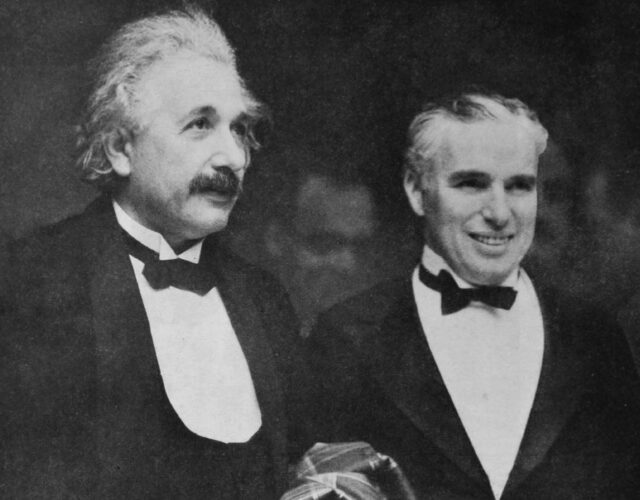Even today, most of us don’t really understand Einstein’s main achievement—the theory of relativity. Which brings up an uncomfortable question. How, then, do we know relativity is true?
About The Disappearing Spoon
The Science History Institute has teamed up with New York Times best-selling author Sam Kean to bring a second history of science podcast to our listeners. The Disappearing Spoon tells little-known stories from our scientific past—from the shocking way the smallpox vaccine was transported around the world to why we don’t have a birth control pill for men. These topsy-turvy science tales, some of which have never made it into history books, are surprisingly powerful and insightful.
Credits
Host: Sam Kean
Senior Producer: Mariel Carr
Producer: Rigoberto Hernandez
Audio Engineer: Jonathan Pfeffer
Transcript
In 1931, a Charlie Chaplain movie called City Lights premiered in Hollywood. Chaplain’s guest of honor at the premier was none other than Albert Einstein. As the two men strolled toward the theater in tuxedos, throngs of people cheered them, screaming and pointing at these two very different celebrities.
Indeed, Chaplain turned to Einstein and said, “They cheer me because they understand me. They cheer you because no one understands you.”
It’s a charming joke, but it gets at a deep truth. Even today, most of us don’t really understand Einstein’s main achievement—the theory of relativity. Which brings up an uncomfortable question. How, then, do we know relativity is true?
The answer is other scientists. They can point to experiments. Einstein’s theories make certain predictions about the world. Scientists can therefore run experiments and see whether the results match Einstein’s predictions. And historically, the results have matched—time and time again.
So what were those experiments? That’s what we’re going to explore in this three-part series.
When we think of Einstein today, we think of the rumpled genius, the wise sage, the worldwide celebrity. He’s St. Albert. But in this series, we’re going back to a time when Einstein was a nobody. An obscure physicist fighting for recognition, trying to prove that relativity worked.
As we’ll hear today, Einstein’s first big breakthrough involved the planet Mercury, work he called the most emotional moment of his life. The next TWO episodes will then cover other experiments by two of Einstein’s oddest disciples—including one who served as the inspiration for Jean-Luc Picard of Star Trek.
Einstein’s triumph was not foreordained. He didn’t just publish his ideas and let people bask in his genius. He had to think about PR and politics. He also had to fight like hell—against both doubters, and against those who wanted St. Albert dead.
Isaac Newton’s laws of motion and gravity are really, really good. With Newton’s laws, you can fly rockets to the Moon, predict eclipses, build steam engines and cars and ships, and do so many other amazing things. So why did scientists eventually replace Newton’s laws with Einstein’s?
The truth is, scientists probably never would have searched for something beyond Newton’s laws if a few embarrassing anomalies hadn’t turned up in the 1800s.
One anomaly involved the orbit of the planet Mercury. But to understand the full story, we’ll have to back up a bit, to one of the more spectacular moments in science history.
In the 1780s, astronomer William Hershel discovered the planet Uranus with a telescope. This was a huge deal—the first new planet discovered since the ancient Babylonians and Assyrians found Saturn. For the first time in thousands of years, the makeup of the heavens changed.
But Uranus was a poorly behaved planet. Astronomers should have been able to predict its orbit and path through the sky pretty easily. That’s because they knew its position and speed and mass, as well as the position and speed and mass of all the other planets that were tugging on it gravitationally. So according to Newton’s laws, the calculations should have been easy.
But Uranus never quite moved the direction it was supposed to. It was always a tad off. Or it moved a little faster or slower through the sky than expected. Something was just funny about Uranus.
This mystery persisted for seventy years. Then, in the 1840s, a French astronomer named Urbain Le Verrier proposed an ingenious solution.
Le Verrier was a thin, stately man regarded as one of the most arrogant scientists in history—which is saying something. He ran an observatory in France for thirteen years, and in those thirteen years, he bullied 13 colleagues and 46 assistants into quitting. He’s been accused of driving one colleague to suicide.
But Le Verrier was undeniably brilliant. And he had a hunch about why Uranus was misbehaving. Seventy years earlier, Hershel had shaken astronomy by discovering a seventh planet in Uranus. But why stop there? What if there were eight?
If there were eight, then the extra planet would be tugging gravitationally on Uranus as it circled the Sun. Sometimes that tug would slow Uranus down, sometimes speed it up. It could tug Uranus out of position as well.
So Le Verrier sat down and started calculating. He used Newton’s laws of gravity and motion. If Uranus was here initially, and then moved there instead of there, where would this hypothetical eighth planet need to be to explain the discrepancy?
It sounds easy, but these calculations were actually grueling. They took months. Finally, a weary Le Verrier told a fellow astronomer to train his telescope on a certain patch of sky, and search for a faint but moving object. Sure enough, there it was—a new planet, right where Le Verrier predicted. We now call this planet Neptune.
Neptune’s discovery staggered the world. Herschel had at least seen Uranus first with a telescope. Le Verrier had conjured up a whole new planet using nothing but math! It was considered the ultimate triumph of Newtonian physics. And it caused Le Verrier’s healthy ego to inflate even more.
But his ego would soon deflate, thanks to Mercury.
Like Uranus, astronomers always noticed something a bit off about Mercury’s orbit around the Sun. The Mercury discrepancies were far tinier than the Uranus ones—barely detectable. But they persisted year after year.
Now, to Le Verrier, only one thing could explain Mercury’s not-quite-right orbit. There had to be another unknown planet tugging on it. This proposed planet would be tiny, and it would have to orbit quite near the Sun, making it fiery hot. Le Verrier named the hypothetical planet Vulcan.
Now, however much of an ass, Le Verrier always worked hard. He buckled down and repeated the grueling Newtonian calculations on Mercury. At the end of which, he told another astronomer where to search for Vulcan. And the astronomer quickly found it. Another triumph!
Except, a few other astronomers looked as well—and did not find Vulcan. The whole claim fell apart. Which was embarrassing. So Le Verrier adjusted his parameters, fiddled with his calculations, and pointed to a different patch of sky. Look there, he said.
Sure enough, someone else found Vulcan there. But once again, other astronomers peered closer and found nothing. Vulcan evaporated a second time.
And this just kept happening. Le Verrier would fiddle with his calculations and point to some new patch of sky. Some astronomer would claim to find Vulcan there. But the claim always fell apart under scrutiny.
Vulcan soon become the Loch Ness monster of astronomy. There were so many bogus sightings that in 1876 Scientific American magazine refused to publish any more supposed discoveries.
Gradually, astronomers accepted that Vulcan didn’t exist. This was a painful admission. If the discovery of Neptune was the ultimate triumph of Newtonian physics, the disappearance of Vulcan was the first crack in the armor. Because without it, no one knew how to explain Mercury’s funny orbit.
And this wasn’t the only failure of Newton’s physics in the 1800s. A second anomaly involved the speed of light.
The fight over the speed of light began in 1887 with two scientists in Cleveland. Albert Michelson and Edward Morley.
Now, I’m going to oversimplify here. Michelson and Morley were actually trying to detect something called the luminiferous ether, the medium that light waves supposedly traveled through.
But to cut a long story short, the experiment required Michelson and Morley to measure the speed of light under different circumstances. And they found something bizarre—that the speed of light was always the same. If they were moving away from a light source, the speed was 186,000 miles per second. But if they moved the opposite direction, toward the source, they got the same speed—186,000 miles per second.
Which doesn’t make sense. Consider this analogy. Imagine you’re in a rowboat in a river. You’re tied to a tree, so you’re stationary. And you measure the speed of the current. Let’s say it’s ten miles per hour.
Now, start rowing downstream. If you measure the current again, you’ll get a speed less than ten miles per hour. That’s because you’re going the same direction as the current.
Next, let’s say you turn around and row upstream. If you measure the current now, you’ll get a speed greater than ten, because you’re moving against the current.
The main point is this: depending on whether you’re moving one direction or another, the speed changes. It’s common sense. More to the point, it’s what Newton’s laws of motion predict.
So why didn’t Michelson and Morley find the same thing with light? After all, the situations are similar. They were moving one direction, then another. Common sense says that the speed of light should change in those cases. But it didn’t. The speed of light stayed the same. This was yet another embarrassing failure for Isaac Newton.
But the failures for Newton, were opportunities for Albert Einstein.
Success did not come easily to Einstein. He attended university in Switzerland and was the only member of his graduating class to not secure a professorship upon graduating.
He couldn’t even find work as a high-school teacher! In fact, he was pathetically grateful when a friend secured him a job as a patent clerk. Which is a perfectly cromulent job. But not what we picture Albert Einstein doing.
Then came the most important year of Einstein’s life—1905. That year Einstein published a series of papers that—get ready—proved the existence of atoms; laid the foundation for both quantum mechanics andrelativity; and introduced the most iconic equation in all of science, E=mc2.
Now, I’m not even going to try and explain how Einstein did all that in one year. Science doesn’t truck with miracles, but Einstein’s 1905 is the equivalent of water into wine or the loaves and the fishes. You can only marvel at his genius.
And Einstein wasn’t done. In the decade after 1905, Einstein’s personal life fell apart. He endured an ugly divorce, and the tragic idiocy of World War I crushed his spirit. But he kept plugging away at his science. And mid-war, in 1915, he published a revolutionary new theory about gravity. It was called the general theory of relativity. And remarkably, this theory offered an answer to an age-old mystery: What exactly is gravity?
Now, it’s interesting. Back in the 1600s, Isaac Newton came up with universal laws of motion and gravity. The basis of these laws was certain equations, and those equations worked brilliantly.
Famously, though, Newton refused to speculate on what gravity actually was. As Newton essentially said, My equations work. Just shut up and calculate. What more do you want?
But people did want more. Philosophers blasted Newton left, right, and sideways. And they had a point. They said, How can Newton claim to understand gravity with mere equations? We want to know what gravity is deep down.
Eventually, though, the wild success of Newton’s equations pushed this issue aside. Again, with Newton’s laws, you can fly rockets, predict eclipses, build cars and ships. Amazing things. Given that success, people were content to shut up and calculate.
Which meant that, even into the 1900s, scientists hadn’t answered the basic question of what gravity is. Well, in 1915, Einstein’s general relativity finally provided an answer. In short, gravity is curved space-time.
To see what this means, imagine a bowling ball on a trampoline. The ball is heavy, so the trampoline’s surface will dip down and curve. Now imagine rolling a golf ball across the trampoline. The dip of the surface will cause the golf ball to follow a curve as it rolls. It might even roll right toward the bowling ball, as if the bowling ball sucked it in.
The same thing happens with space-time. A heavy piece of matter like a star causes space-time to curve like the trampoline. And if a comet or planet moves into that curved space-time, the star tugs on it and the planet or comet changes its path. Or if the planet moves fast enough, it will circle around the star in orbit.
So that’s what gravity is—space-time that’s curved, due to the presence of matter.
With this insight, Einstein took on the problem of Mercury’s funny orbit.
Again, Mercury wasn’t appearing quite where it was supposed to in the sky. And there’s a reason he took on this specific problem. Public relations. I don’t know about you, but I think of Einstein as the stereotypical absent-minded professor. Messy hair, untied shoelaces. Probably doesn’t know what day of the week it is, right?
In reality, Einstein was a shrewd operator. He knew that Isaac Newton was revered. And at the time he proposed general relativity, Einstein was a nobody. Why would anyone believe his theory of gravity was better than Newton’s? They wouldn’t. Unless he made a big splash. And Mercury would be his big splash.
In most cases, Newton’s old law of gravity and Einstein’s new law of relativity give the exact same answers. They differ only at the margins. Especially when you’re near a huge, massive body. Like our Sun. When you get really close to something big like the Sun, Newton’s theory starts to fray. That’s because Newton considered only the mass of the Sun, and didn’t consider the extra effect of curved space-time.
In contrast, Einstein did take curved space-time into account. And because Mercury is so close to the Sun, he knew that its orbit was probably affected a lot by curved space-time. At least he hoped so. He still had to prove it.
So he got to work calculating. Plugging in numbers. Shifting variables. Adding and multiplying. Carrying the one or whatever. Then he watched with amazement as the correct orbit of Mercury simply fell right out of his equations.
Far from playing it cool, Einstein later recalled that his heart began to race. He felt something “snap” inside him. A friend speculated that solving the mystery of Mercury’s orbit was the most intense emotional experience of Einstein’s scientific life—maybe even his entire life.
And no wonder. This experience is what scientists call the “golden moment.” It’s the moment they first discover something that no one else knows. They have to tell colleagues eventually, of course. But for a few golden hours, they’re the only human being in history who knows some eternal truth.
Scientists are blessed if they get one golden moment in their lifetime. Einstein—that greedy bastard—had several. But none was more golden than when he finally solved the mystery of Mercury’s orbit. He had staked his entire reputation on the theory of general relativity. And the theory had come through in a gigantic way.
This was a brilliant start to Einstein’s campaign to win acceptance for general relativity. But the campaign wasn’t over. For instance, what about the Michelson-Morley experiment on the bafflingly constant speed of light?
And beyond experiments, Einstein also had to deal with his fellow scientists. Over the next few years, some of them would smear him, call him racial slurs, seek to destroy him. But Einstein had one powerful weapon on his side. The truth…




